Kaua‘i’s Udderly Gourmet Goats
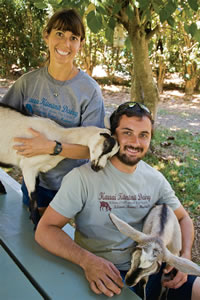
Sarah and Ryan Wooton and friends. Daniel Lane photos
I’m sitting at a picnic table in the shade of a massive avocado tree in Kilauea. The ocean reflects a cloudless sky on a sultry morning. Sarah Wooton places freshly baked cookies still warm from the oven and cold limeade on the table, and sits down next to her husband.
Katelyn and Shauna, a couple of 3-month-old goats, spring onto the table. Frolicking like children, their spindly legs clomp toward the cookies. Sarah snatches the plate before they get a taste. Katelyn is undaunted, and beats straight for my limeade. Her tongue swipes at the condensation pooling along the bottle before she’s shooed off the table.
Skittering to the ground, they scout for more food. I feel a nibble on the leg of my capris and giggle.
“People think goats eat everything,” Sarah explains, “but they’re really just tasting with their lips.”
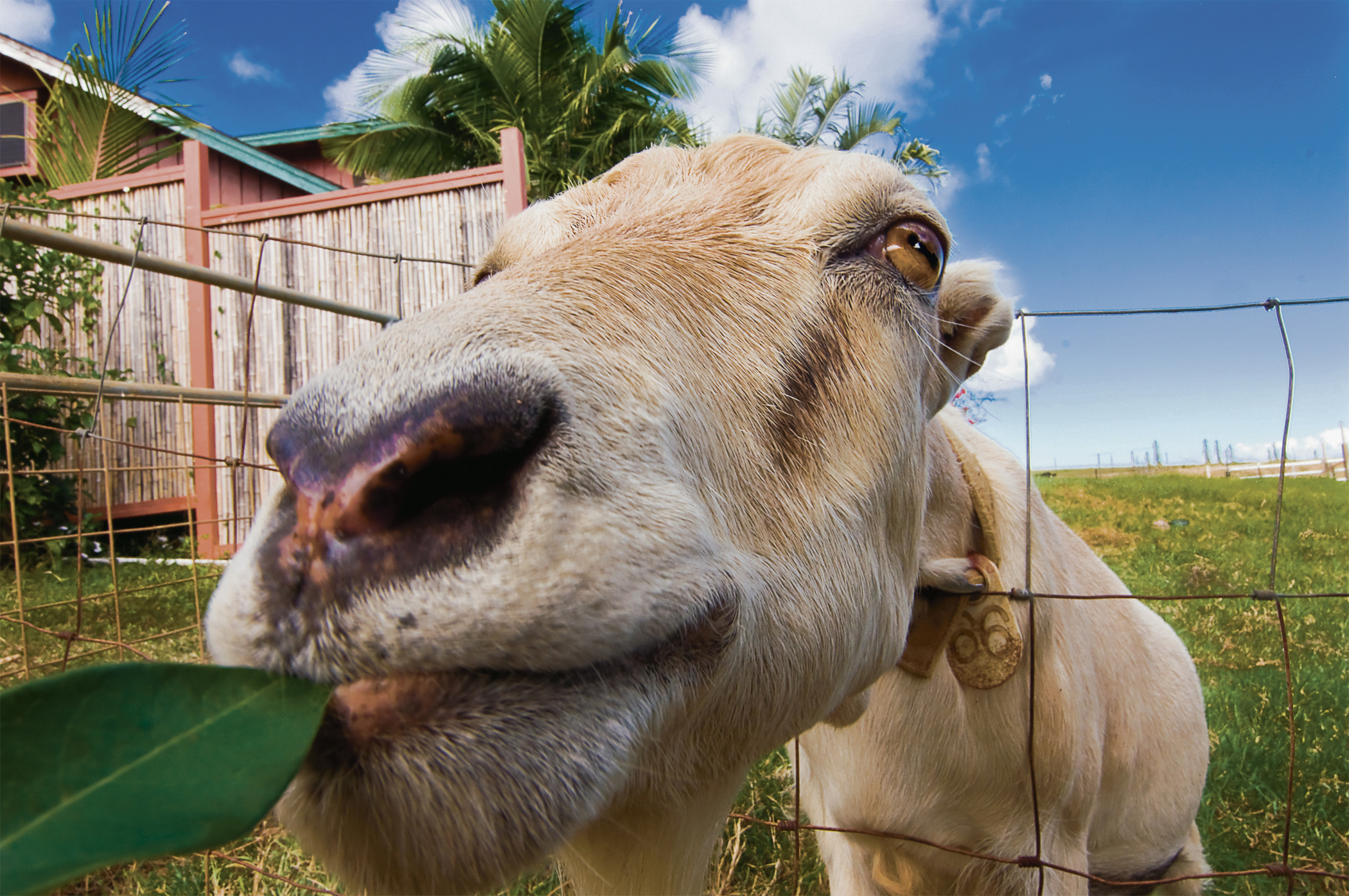
Goats taste with their lips
Ryan and Sarah Wooton help run Kaua’i Kunana Dairy, the only goat farm on Kaua’i that makes cheese along with honey, salad dressings, hot sauces, pesto, baked goods and body products made with goat’s milk or beeswax.
While most children of farmers migrate to greener pastures, the young couple traded photography careers in Montana for family farming on Kaua’i. But the innovative duo does more than keep the family business alive; their line of value added products has created a thriving enterprise.
“In 1979, my mom made goat milk soaps and body products in bulk, and sold it to companies on the Mainland,” explains Ryan. “In 1991, they got this property, and it took about eight years to become a certified dairy.
“Bob is a retired general contractor and built the structures on the farm, including the commercial kitchen,” Ryan says of his 70-year-old father. “This farm wouldn’t run without my dad because he fixes anything that breaks down. Anything that needs to be built, he builds.”
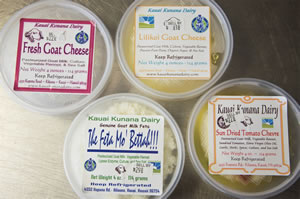
Fresh, Kaua‘i-made cheese. Daniel Lane photos
The farm consists of a one-acre certified organic garden, two acres of fruit orchards, 15 beehives and 60 goats made up of four breeds that rotate through 10 acres of pasture.
“We are Kaua’i’s only Animal Welfare Approved farm,” says Ryan, who was born and raised on the island. “That means the guidelines are very stringent for the care of our animals, and my mom Louisa makes sure we follow those guidelines.”
Bundles of pasteurized goat’s milk wrapped in cloth are suspended over sinks in the farm’s commercial kitchen. The steady stream of draining whey indicates the cheese is not ready to eat.
“One gallon of milk weighs about 7 pounds,” Sarah explains as we stand in the cool, sparkling-clean kitchen. “And 1 gallon of milk makes about 1 pound of cheese.”
Ryan nods his head in agreement and adds, “We make about 200 pounds of cheese a week.”
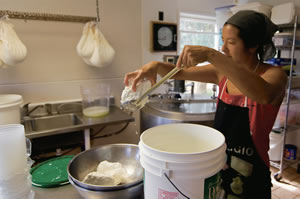
Cynthia Chiang packages fresh feta
Employee Cynthia Chiang carefully removes large chunks of crumbly feta from a 5-gallon bucket of salted brine and places them in containers set on scales. These will go to 16 restaurants on Kaua’i that serve their gourmet cheese.
Chiang pinches off a piece and offers it to me. It smells clean, like sea mist on a fresh Kaua’i morning. I put the nugget in my mouth. It’s moist, a little tangy and creamy. Most feta is chalky, without much flavor, but this is a mouthful of flavor. It’s the best feta cheese I’ve ever tasted.
“It’s a traditional Greek feta,” Ryan says. “Not many people are familiar with Greek feta. Nowadays, it’s made commercially with cow’s milk and it’s a different creature.”
I like Greek feta, but this one blows its competition away, maybe because it’s traveled several feet to my mouth, not thousands of miles.
Sarah brings out their line of chèvre, which is the French term for goat cheese. Six flavors range from plain, lilikoi, artichoke, garlic chive and sun-dried tomato to marinated herb with olive oil, garlic, fresh thyme and rosemary. Each bite is sublime, super creamy and there’s not a trace of goat funk anywhere.
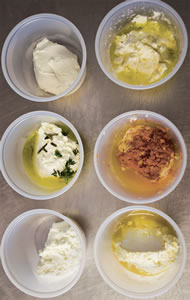
There are six varieties of goat cheese to choose from
“Making goat cheese is a science,” says Ryan, explaining why his goat cheese is so creamy. “You have to blend it perfectly.
If you overdo it, it’ll be hard or grainy.”
Art or science, this handblended goat cheese is as smooth as the voice of Iz.
And there’s an added benefit.
“Goat’s milk is easier for your body to digest,” says Sarah. “It’s closer to human mother’s milk and the fat molecules are smaller. It takes 20 minutes to digest goat’s milk, and two to three hours to digest cow’s milk.”
If you want to get your hands on some of Kaua’i Kunana Dairy’s artisan cheese or any other products, visit the following farmers markets: Tuesdays at Waipa, Saturdays in Hanalei or at Kaua’i Community College in Lihu’e.
Kaua’i Kunana Dairy 651-5046 Farm tour/cheese tasting $35, free for keiki under 12 kauaikunanadairy.com



